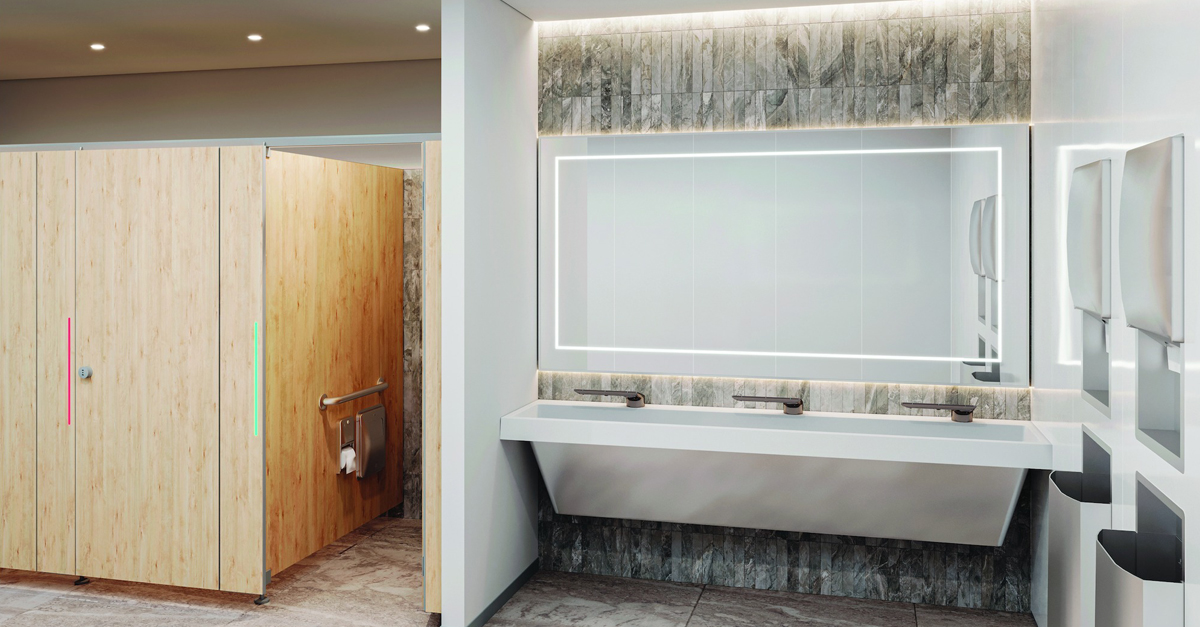This article originally appeared in FMJ, the official magazine of IFMA. Its inclusion on CMM’s website is part of a strategic partnership between ISSA, which owns the CMM brand, and IFMA.
One might say that commercial restrooms are the unsung heroes of commercial buildings. They are indispensable, unique, one-of-a-kind public spaces that seem to get a bad rap more often than not. Yet they increasingly require facility management’s time, attention, and care.
Every commercial building has a restroom—sometimes multiple facilities—that are used by almost every person who enters the building. As such, public restrooms are high-use and high-visibility, making them high-impact areas for all building occupants and stakeholders.
Restrooms are distinctive in that they are tight enclosed spaces in which people use toilets, have many germy touchpoints (about 10 in a single visit), and contend with indoor air quality issues, including airborne pathogens as well as disagreeable odors.
Additionally, restrooms utilize volumes of water, soap, and paper products that are costly and can potentially create mess, slips, and falls as well as breed bacteria. They also require facility staff’s time and energy for regular cleaning, restocking, and maintenance throughout the day.
To a layperson, restroom maintenance may seem straightforward and a business no-brainer. However, limited budgets and facility staffing issues mean that companies are having to do more with less staff and resources. Today, over-stretched maintenance staff are on the lookout for restroom products, technologies, and features that improve maintenance, save time, cut costs, and make their jobs easier.
Upgraded maintenance strategies
Fortunately, new solutions are available to support restroom cleanliness, infection control, and reliable handwashing for building occupants while optimizing maintenance and driving efficiency. For example, restroom products with maintenance indicators, internet of things (IoT) connectivity, and alternating current (AC) power—rather than batteries—simplify maintenance capabilities. Sustainable product designs like all-in-one handwashing models and nonporous sink materials also help reduce germs and upkeep.
Not only do maintenance indicators give facility staff advance notice when something needs to be refilled, restocked, or addressed in some way, this smart technology also gives building occupants confidence in knowing that the restrooms will be regularly stocked and cleaned.
To further anticipate and enhance restroom maintenance, it is also important to recognize the current drivers of change that are impacting restrooms and the people who use them.
Elevated expectations for restroom hygiene
Today, the public’s expectations for clean restrooms are higher than ever. Increased demand stems from worldwide public infectious health concerns, such as the coronavirus pandemic and the spread of any germs that cause illness, whether it be a COVID-19 variant, respiratory syncytial virus (RSV), norovirus, or influenza virus. People associate a hygienic restroom experience with health, safety, and well-being. While it has always been important for a restroom to look and smell clean, now it is an absolute necessity.
There is also a strong relationship between a restroom’s cleanliness, maintenance, and functionality and a business’ or establishment’s overall image and even profitability.
Research illustrates how customers place a high value on clean restrooms—and reward businesses that offer them. According to the 2023 Healthy Handwashing Survey™ conducted by Bradley Corp., 60% of Americans say they would willingly spend more money at a business with clean, well-maintained restrooms. Another 60% say when out running errands they take restroom breaks at a business they know has “good” restrooms.
Conversely, “bad” restrooms have the opposite effect. More than half of respondents say an unclean or unpleasant public bathroom shows poor management and causes them to lower their opinion of the overall establishment. Slightly more than half (52%) also say a negative restroom experience causes them to vow not to return in the future or think twice about doing so.
Identifying restroom user pain points and grievances
Unfortunately, restrooms intrinsically carry a certain “ick factor” that impacts how people view and use these public facilities. In turn, these perceptions and behaviors affect—and inform—facility maintenance strategies.
According to the survey, the most common restroom frustrations include clogged or unflushed toilets; an overall appearance that is old, dirty, or unkempt; unpleasant smells; and empty or jammed dispensers for soap, toilet paper, and hand towels.
Another pet peeve uncovered by the survey is having to touch bathroom surfaces, which is not surprising as people continue to be in an elevated state of germ consciousness following the pandemic. Plus, no one wants to touch things after somebody else just touched them, especially right after using the toilet. The majority go out of their way in bathrooms to avoid any skin contact. 62% use a paper towel as a barrier to avoid touching flushers, faucets, and doors. Women are even more likely to rely on paper towels, with 67% taking this evasive measure.
Others employ sheer physicality to steer clear of germs:
- 43% use their foot to flush toilets (much to the dismay of maintenance staff since flushing mechanisms can get stuck or break)
- 31% hover over the toilet seat
- 27% open and close doors with their backside in hopes of avoiding contact.
Women are significantly more likely than men to employ these actions.
Cleanliness routinely tops lists of restroom improvements users would like to see. Access to touchless fixtures and better stocking of supplies, such as toilet paper, soap, and paper towels, were other high requests.
Touchless restroom fixtures
With so much effort going into evading germs, it is no wonder that 82% of adults believe it is important to have touchless fixtures in a public restroom and 60% say they are more likely to return to a business that offers no-touch capabilities in its restrooms. It appears the days of handled and levered faucets in restrooms are numbered and touch-free technology is the new gold standard.
In the U.S., the top touchless restroom features considered most important are faucets, flushers, soap dispensers, and paper towel dispensers.
The good news for building staff and restroom users alike is that the mechanicals used in sensor technology have been improved over the past several years. Specifically, faucets incorporate highly sensitive sensors and options for ultra-low flow demands. While some older touchless models include sensors that deliver unreliable soap and water activations, today’s designs incorporate advanced sensing technology ensuring continuous washing, and less soap splotches leftover in and around the basin.
From an operational efficiency standpoint, touchless fixtures are easier to keep clean, maintain, and service than manually activated fixtures. While automated technologies may require some modifications to the existing plumbing and electrical systems, they are often relatively straightforward for retrofitting into a current restroom space.
All-in-one handwashing designs
One type of touchless handwashing technology is a completely touch-free all-in-one design. By combining soap, faucet, and hand dryer into the handwashing system, hygiene, maintenance, accessibility, and sustainability are simultaneously improved.
This handwashing concept also improves water containment inside the washbasin, as the hand dryer is engineered to work with the basin to keep water in the bowl. This prevents water from dripping from hands onto the user, walls, and floors to eliminate slips, trips and falls and extra floor mopping.
Top-fill multi-feed soap systems
With all-in-one handwashing models, an efficient top-fill multi-feed soap system can significantly cut down on soap refills for maintenance staff. This new soap system incorporates a large capacity 1.3-gallon (5 liter) tank that can supply up to three units, allowing staff to efficiently refill multiple soaps through a single top-fill hub. A smart sense system with LED indicator shows when soap/battery levels are low and provides audible and visual indicators to prevent overfilling. This multi-feed soap system accommodates liquid or foam soap, and is especially ideal for high-traffic applications with multiple handwashing stations.
Hygienic and sustainable materials and fixtures
Using smooth, nonporous materials with seamless construction like solid surface and natural quartz makes washbasins hygienic, sustainable, and visually stunning. These durable, cast-formed materials help prevent bacteria and mold accumulation and growth; can be easily cleaned, disinfected, repaired, and reused; and last the life of the building. Natural quartz and solid surface materials can be GREENGUARD Gold-certified.
For soap and faucet fixtures, physical vapor deposition (PVD) coatings are a more sustainable way to finish metals than traditional electroplating. These popular and attractive finishes are produced with PVD, an advanced process that creates a molecular bond to the fixture, creating a resilient coating that will not corrode or fade. Colors like brushed black stainless, bronze, brass, and nickel add modern accents and character to restroom designs.
In the future, expect to see more water-saving fixtures like sensor-controlled faucets with adjustable low-flow rates, low-flow toilets, waterless urinals, and energy-efficient hand dryers.
Warm and welcoming restroom appearances
Long gone are the days of cold, barren, institutional-looking commercial restrooms. Today’s end users are drawn to elevated, well-designed restroom spaces.
The world’s most notable restrooms convey beauty, architectural style, ease of use, and comfort. These restrooms often incorporate features like building materials and décor that mirror our natural surroundings, sleek no-touch fixtures, warm ambient lighting, restroom partitions designed for privacy, and matching styles of washroom accessories that unify restrooms and enhance the user experience.
Internationally, the sky is the limit for accentuating restrooms with fresh and modern design elements, as well as for providing clean and well-maintained spaces. Today, facility managers have more tools, materials, and technology options than ever to help foster operational efficiency, hygiene, functionality, appearances, and even increased business.



